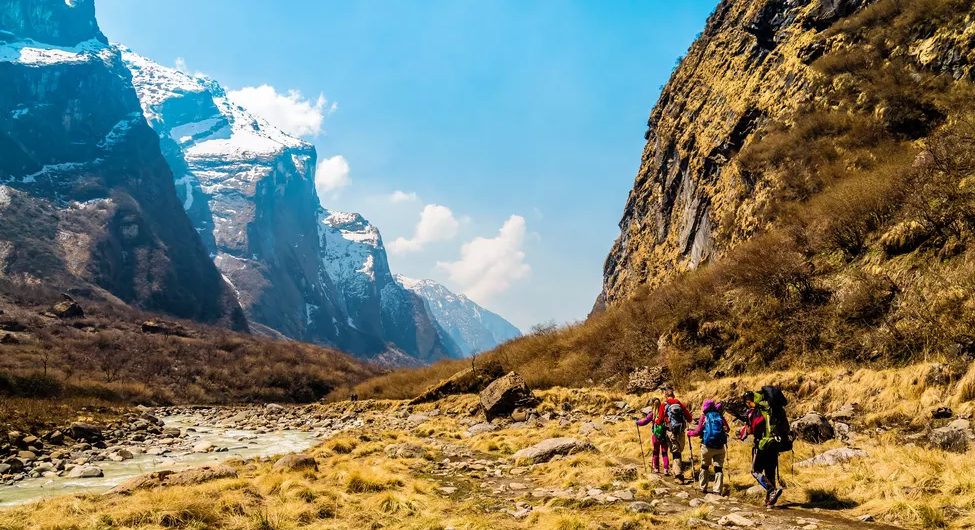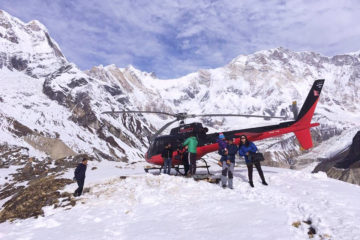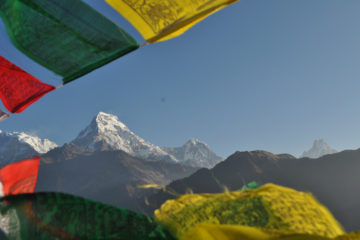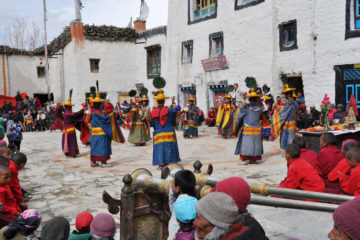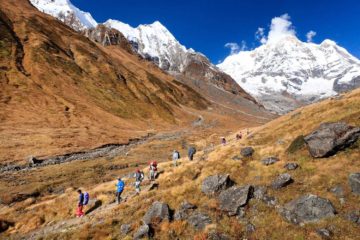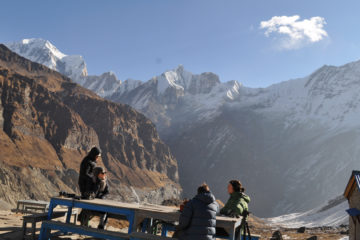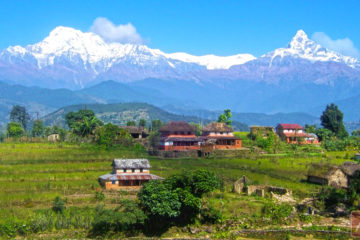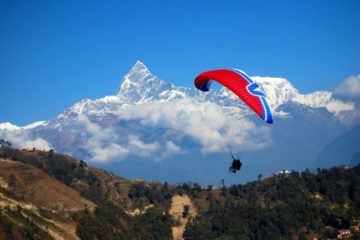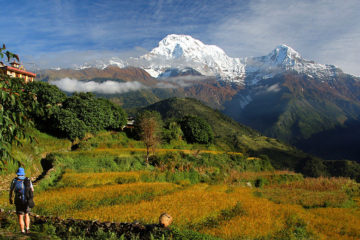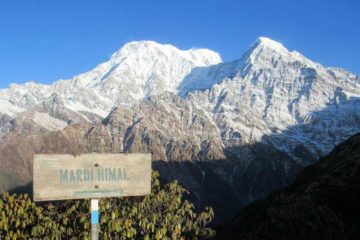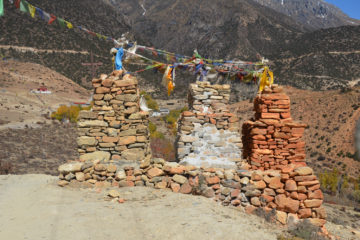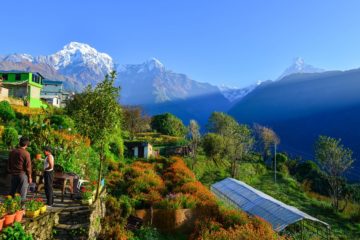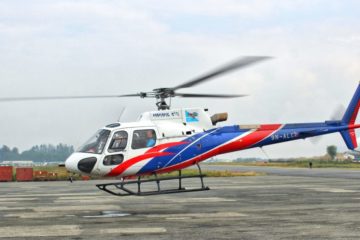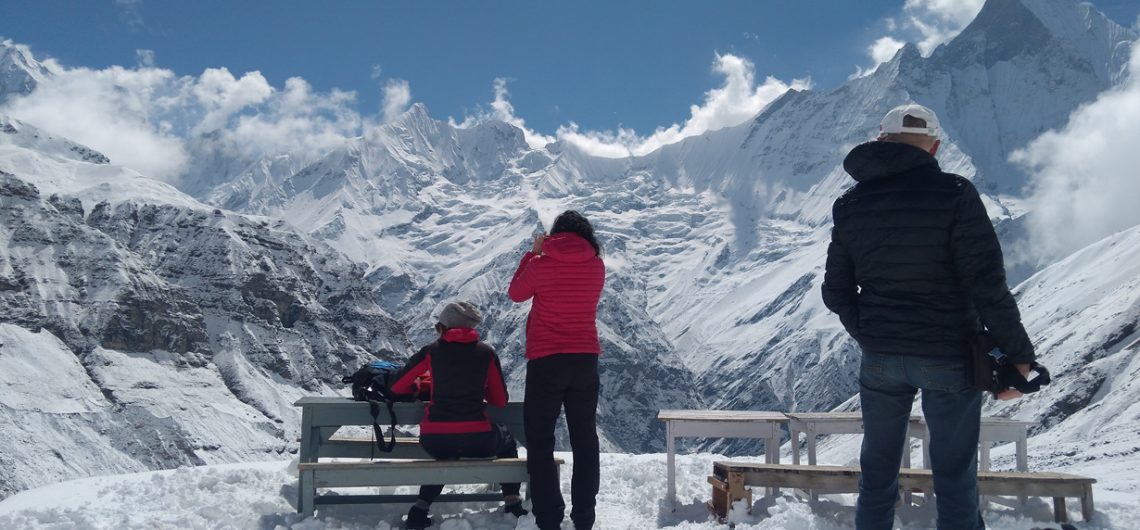The Annapurna region is situated in middle north Nepal and is defined by the Kali Gandaki River to the west, the Marsyangdi and Dudh Khola valleys to the east, the Pokhara valley to the south and the Himalaya foothills that run along the Nepal-Tibetan border to the north.
Annapurna is a section of the Himalayas in north-central Nepal that includes 8,091 m Annapurna I, thirteen additional peaks over 7,000 m and 16 more over 6,000 m. Annapurna is a Sanskrit name which literally means “full of food”, but is normally translated as Goddess of the Harvests.
The Annapurna region is a dream for independent trekkers. It combines some of Nepal’s most iconic mountains, including fish-tailed Machhapuchhare and massive Annapurna itself, with a superb trekking infrastructure and easy access, as most trailheads are just an hour or two from Pokhara. The region’s charming Gurung, Manangi and Thakli villages add a cultural highlight.
The Annapurna Region has renowned as one of the world’s greatest treks. While most trekkers follow the standard route there are a number of interesting side trips that can be added or alternate shorter treks if one lacks time to complete the entire circuit. Here we give a brief summary of the Annapurna Circuit as well as the possible side trips and alternate routes.
Annapurna Trekking Region features the highest lake in the world—Tilicho (4920m), the highest pass in Nepal—Thorong La Pass (5416m), and the holy temple of salvation—Muktinath (3800m).
Nepal Tours offers camping and tea house trekking for 1 day to 20 days hiking treks to all of the above Annapurna destinations. If you are interested in exploring the Annapurna Region, below are some of the itineraries, or alternatively we can be in contact so you may personally tailor your own itinerary.
Main Attraction of Annapurna Region
- Biggest Conservation Area of Nepal
- World 10th highest mountain in the world – Annapurna I and world Seven highest mountain Dhaulagiri
- World Highest Lake (Tilicho Lake)
- Best View of Annapurna Range
- Old and Historical Monasteries, Stupa and Temples.
- Kali Gandaki, deepest gorge in the world.
- Annapurna Circuit, one of the world’s classic long-distance hiking trails.
- Muktinath Temple, sacred place to both Hindus and Buddhists.
Flora & Fauna in Annapurna Region:
Nepal abounds with some of the most spectacular sceneries in the whole of Asia, with a variety of fauna and flora also unparalleled elsewhere in the region. Between Nepal’s geographical extremes, one may find every vegetational type, from the treeless steppes of the Trans-Himalayan region in the extreme north and the birch, silver fir, larch and hemlock of the higher valleys to the oak, pine and rhododendron of the intermediate altitudes and the great sal and sissau forests of the south.
Ethnic Communities in Annapurna Region:
Annapurna region is the home to over 150,000 inhabitants from over 10 ethnic groups (Tibet- Burmese:-Gurung, Thakali, Bhotia, Ethnic Tibetan, and Magar; Manangi and Indo Aryan; Brahmin, Kshetri, Kami, Damai and Sarki), of which ethnic backgrounds have ruined a livelihood out of its gentle hillside.
Permits and Fees in Annapurna Region:
There are two types of trekking permit required by anyone wishing to trek the Annapurna region.
-
-
Trekkers Information Management System (TIMS)
-
TIMS or Trekkers Information Management System is a must for every trekker wishing to trek in Nepal. This is a basic permit implemented jointly by Nepal Tourism Board (NTB) and Trekking Agencies Association of Nepal (TAAN) to ensure the safety and security of every trekker wishing to trek in Nepal.
Cost: TIMS permit: 1,000 NPR (Approx. US $10)
-
-
Annapurna Conservation Area Entry Permit (ACAP):
-
The Annapurna region was gazette a conservation area by the government of Nepal in 1992 and is the largest protected area in Nepal. Every trekker wishing to trek in the Annapurna region needs to purchase ANCAP or Annapurna Conservation Area Entry Permit. The Annapurna Conservation area is located across Manang, Myagdi, Lamjung, Mustang districts of Nepal. It was established with the aim of creating a sustainable economic and social development to benefit the local people of the region. It is managed by the National Trust for Nature Conservation. Some portion of the cost for the ANCAP goes to the trust for the conservation of this beautiful region.
Cost
ACAP try permit fee for foreigners: 3,000 NPR (Approx. US $30)
ACAP entry permit fee for SAARC nationals: 200 NPR
Note: Any individual trekker below the age of 10 doesn’t require purchasing this permit.
When is the best time to go?
The best weather for trekking in the Annapurna region is during autumn (September to November) and spring (March-May). The skies are clear then and you will get a chance to enjoy some outstanding views of the Annapurnas and Dhaulagiri peaks. Keep in mind that even though it is not monsoon season anymore it will be much warmer and humid in the lower regions (jungle) and you still may encounter an unexpected shower or two. It will also be much cooler above 3500m. Even though it’s not technically winter you will need warm clothes and a down jacket.
Weather and Temperature in Annapurna Region:
On the lower regions of the Annapurna Circuit trek, the weather is generally warm. The days have an average temperature of 15 degrees Celsius. The nights are slightly colder at 7-8 degrees Celsius. The higher altitudes are colder. Recommend to see the weather forecast before to leave the trek.
Annapurna region after Earthquake
Not all the trekking regions of Nepal suffered the devastating Earthquake. Some of the trekking regions even escaped the earthquake without a scratch. The good news is that the trekking region like Kanchenjunga, Makalu, Annapurna, Dhaulagiri, Lower and Upper Mustang, Dolpo, Humla, and Jumla escaped the widespread damage. And they were ready to welcome travelers by the trekking season in Autumn 2015. The famous Annapurna region has escaped the earthquake. So, many travelers planned their trip to the beautiful Pokhara city. And, trekked in the Annapurna trails under the shadow of breathtaking mountain ranges.
Annapurna Region Trek Options
Pokhara to Annapurna Helicopter Tour
Ghorepani Poon Hill Trek
Tiji Festival Jeep Tour 2024
Tiji Festival Trek 2024
Annapurna Circuit Trek
Annapurna Sanctuary Trek
Begnas Thulokote Hiking - 1 Day
Pokhara Day Tour
Annapurna Luxury Lodge Trek
Mardi Himal Trekking
Upper Mustang Trekking
3 Days Trek Pokhara
2 Days Trek Pokhara
Heli Sightseeing Pokhara
Part of source contain: https://en.wikipedia.org/wiki/Annapurna_Circuit

